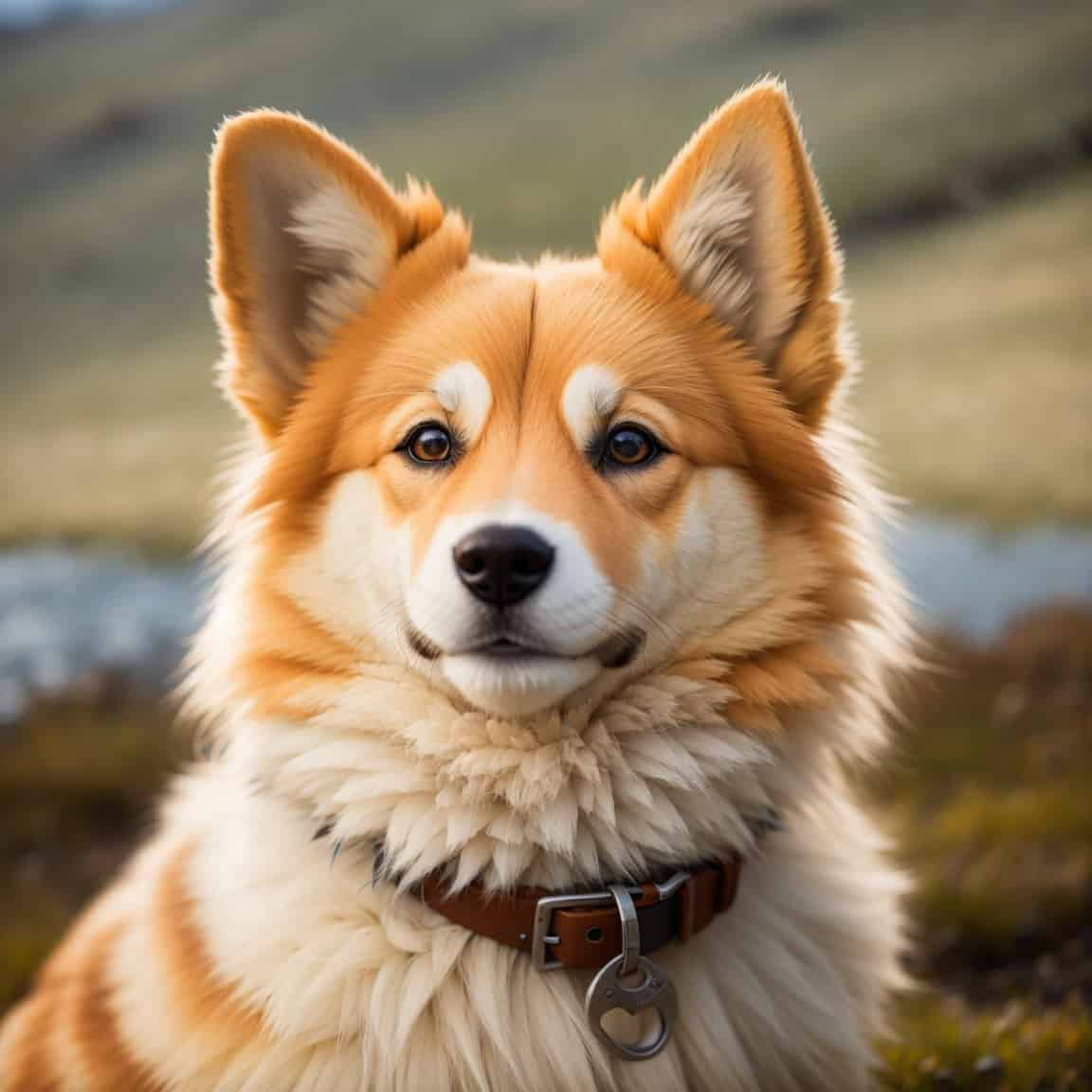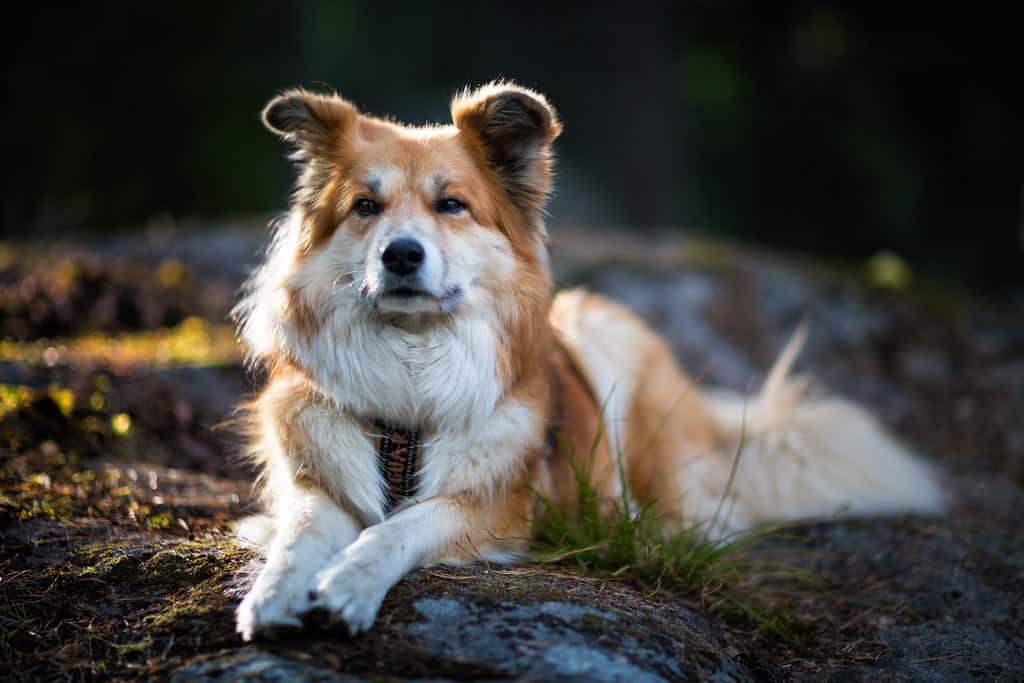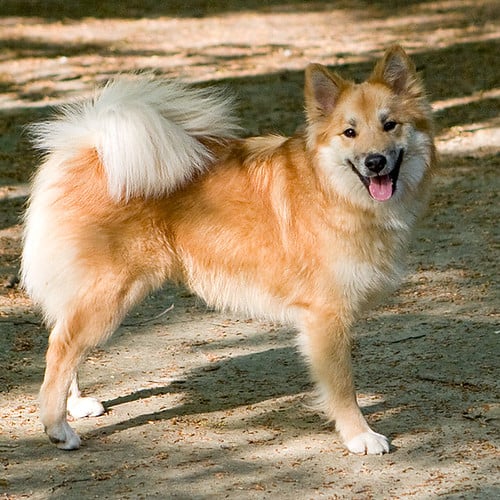The Icelandic Sheepdog, a picture of charm, unwavering loyalty, and exceptional herding skills, has become a beloved choice among dog enthusiasts and farmers. With its Icelandic origins, distinctive physical features, and a unique set of personality traits, this breed is celebrated as an agile and dependable herding dog with a friendly and endearing nature.

| Category (Explanation) | Breed Information |
|---|---|
| Year of Breed Conception | 9th century |
| Country of Origin | Iceland |
| Weight (lbs & kg) (Male) | 20-30 lbs (9-13.5 kg) |
| Weight (lbs & kg) (Female) | 20-28 lbs (9-12.5 kg) |
| Coat Type | Double coat with a thick, weather-resistant topcoat |
| Color Variations | Various colors, often with white markings |
| Shedding Level (Low, Moderate, High) | Moderate |
| Height (cm & in) | 16-18 inches (41-46 cm) |
| Breed Size | Small to medium |
| Trainability (Low, Moderate, High) | High |
| Mental Needs (Low, Moderate, High) | Moderate |
| Intelligence Level (Low, Moderate, High) | High |
| Energy Level (Low, Moderate, High) | Moderate |
| Agility (Low, Moderate, High) | High |
| Loyalty (Low, Moderate, High) | High |
| Playfulness (Low, Moderate, High) | High |
| Exercise Needs | Regular exercise and mental stimulation |
| Guarding Proficiency (Low, Moderate, High) | Low |
| Sociability with Children (Low, Moderate, High) | High |
| Barking Level (Low, Moderate, High) | Moderate |
| Digging Tendency (Low, Moderate, High) | Low |
| Destructive Behavior (Low, Moderate, High) | Low |
| Drooling Level (Low, Moderate, High) | Low |
| Obedience Level (Low, Moderate, High) | High |
| Apartment Friendly (Yes/No) | Can adapt to apartment living with sufficient exercise |
| Inherent Prey Drive | Moderate |
| Physical Risk to Others (Low, Moderate, High) | Low |
| Travel Fatality Risk (Low, Moderate, High) | Low |
| Allergen Potential | Low |
| Health Concerns (List of Common Health Concerns) | Hip Dysplasia, Eye Issues, Epilepsy |
| Average Life Expectancy (Life Expectancy in Years) | 12-15 years |
Woof Mastery is reader supported and our articles may contain affiliate links.
Instead of running third party ads that we have no control of we only use links from high-quality companies we are directly partnered with. Making use of these links come at no cost to you our reader, and in many cases have the extra benefit of discounted rates or sign up bonuses.
If you’re interested you can read more about our affiliate policy here.
We appreciate your support and always insure that the products and services we recommend are high-quality, helpful and relevant to the subject at hand!
The Icelandic Sheepdog’s history is one of resilience and herding in Iceland. These dogs have been herding livestock in the challenging Icelandic terrain for centuries.
Their compact size, intelligence, and weather-resistant coat made them well-suited for herding in harsh conditions. They were cherished for their loyalty and versatility.
Today, Icelandic Sheepdogs are celebrated for their herding abilities and their role in Icelandic agriculture. They are known for their affectionate nature and as loyal family pets.

What makes the Icelandic Sheepdog special is its agility and charming corgi-like appearance. These dogs have a history of herding in the challenging Icelandic landscape. Their loyalty and adaptability make them exceptional working dogs and companions.
Icelandic Sheepdogs have a tradition as herding and working dogs in Iceland. Their agility and herding instincts made them exceptional at managing and protecting livestock. They were known for their resilience and adaptability to the harsh Icelandic terrain. Today, they continue to serve as reliable working dogs and beloved family pets, preserving their heritage as dependable companions.
Icelandic Sheepdogs are known for their spirited and loving personalities. They excel in herding sheep in the challenging Icelandic landscape.
Their agility and herding skills make them excellent herders, and they have a sweet and loyal nature. Icelandic Sheepdogs are characterized by their energy, devotion, and a playful disposition, epitomizing the perfect blend of vitality and affection.
Icelandic Sheepdogs are affectionate and alert. They are typically good with children and other pets but may be reserved with strangers. Early socialization is important for a well-adjusted temperament.
Mental and physical exercise is crucial for their well-being.
Icelandic Sheepdogs are small to medium-sized dogs with a well-proportioned and agile build. They have a slightly rounded head with expressive, almond-shaped eyes and small, triangular ears.
They have a double coat with a dense, weather-resistant outer coat. Coat colors can include shades of red, sable, black and white, or chocolate. Their tail is often carried high and curled over the back.
Males typically stand between 18 to 19 inches (46-48 cm) at the shoulder and weigh between 20 to 30 pounds (9-14 kg), while females are slightly smaller and lighter.
Icelandic Sheepdogs have a friendly and lively presence, reflecting their role as herding and working dogs.
Icelandic Sheepdogs come in shades of red, tan, black, and gray with white markings. They may not have distinct coat colors.
Icelandic Sheepdogs typically have coat colors in shades of red, tan, black, or gray with white markings, but they may not exhibit distinct coat patterns.
Icelandic Sheepdogs have a moderate shedding level. They shed consistently, with increased shedding during seasonal transitions. Regular grooming and brushing can help manage shedding and keep their coat in good condition.
Icelandic Sheepdogs have a double coat that requires regular grooming to keep it healthy and minimize shedding. Grooming habits for this breed include:
1. Brushing: Regular brushing, about once or twice a week, is essential to prevent matting and remove loose fur. Use a slicker brush or an undercoat rake for thorough grooming.
2. Bathing: Bathe Icelandic Sheepdogs when necessary using a dog-specific shampoo and ensure thorough rinsing.
3. Ears: Check and clean their ears regularly with a veterinarian-recommended solution to prevent wax buildup or infections.
4. Nails: Keep their nails trimmed to a comfortable length to maintain proper gait and prevent discomfort.
5. Teeth: Brush their teeth regularly to ensure dental health and prevent bad breath. Dental chews or toys can be beneficial.
6. Tail and Paw Care: Pay attention to the tail and paw areas, where dirt and debris can accumulate. Keep them clean and inspect for any signs of irritation or injury.
Icelandic Sheepdogs have a moderate activity level and thrive on both physical and mental challenges. Key points about their activity level include:
1. Exercise Needs: Icelandic Sheepdogs require daily exercise to stay happy and healthy. Activities can include walks, playtime, and interactive tasks.
2. Energy Level: They have a moderate energy level, especially when young. Regular exercise helps prevent restlessness.
3. Herding Heritage: Historically, Icelandic Sheepdogs were bred for herding and protecting livestock. They excel in activities like obedience training, agility, and herding trials.
4. Mental Stimulation: In addition to physical exercise, mental challenges through training and interactive games are important to keep them mentally sharp.
5. Family Companions: They make good family pets and enjoy spending time with their human companions.
Icelandic Sheepdogs are intelligent and resourceful. They are known for their problem-solving abilities and adaptability. Here are some key points about their intelligence:
Icelandic Sheepdogs’ intelligence makes them effective working dogs and cherished companions when provided with proper training and mental stimulation.
Icelandic Sheepdogs are intelligent and need mental stimulation. Engage them in obedience training and activities that challenge their minds to keep them sharp.
Social Interaction: They are social dogs and require regular interaction with their human family. Loneliness can lead to anxiety or destructive behavior, so provide companionship and attention.
Exercise: Mental exercise is equally important. Offer them tasks that challenge their problem-solving skills.
Training and Obedience: Icelandic Sheepdogs benefit from obedience training and activities that engage their minds. Consistent, positive-reinforcement training is effective in shaping their behavior.
Enter The Woof Mastery

Thinking about an Icelandic Sheepdog? Consider these factors:
1. Activity Level: Icelandic Sheepdogs are active and require regular exercise and mental stimulation.
2. Training Needs: They are intelligent and benefit from consistent training and socialization to prevent behavioral issues.
3. Space: Icelandic Sheepdogs need space to move around comfortably, making them better suited for homes with yards.
4. Coat Care: Regular grooming is important to manage their coat, which sheds moderately.
5. Herding Instinct: Be prepared for their natural herding behaviors and tendencies.
Icelandic Sheepdogs, known for their herding instincts, may pose a physical risk to others if not properly socialized, trained, or managed. The risk assessment factors include:
1. Herding Instinct: Icelandic Sheepdogs have a strong herding instinct, which may lead to chasing or nipping at people or other animals. Proper training is essential to manage this behavior.
2. Socialization: Early and thorough socialization is crucial to ensure Icelandic Sheepdogs are comfortable around people and other animals. Poor socialization can lead to fear or aggression.
3. Training: Obedience training is essential to teach Icelandic Sheepdogs appropriate behavior and ensure they respond to commands. Well-trained dogs are less likely to engage in aggressive behavior.
4. Owner Responsibility: Responsible ownership involves being aware of the dog’s behavior and taking necessary precautions in public settings.
5. Breed-Specific Legislation (BSL): Icelandic Sheepdogs are generally not subject to BSL, but owners should be aware of local regulations.
6. Individual Variability: Each dog is unique, and behavior can vary. Responsible ownership, proper training, and socialization are key to minimizing the potential physical risk to others.
Icelandic Sheepdogs are usually good with children. They are affectionate and may form strong bonds with kids. Proper socialization and training are important to ensure positive interactions with children.
Icelandic Sheepdogs may be capable swimmers, but their preference for water activities varies. Their coat colors do not affect their swimming ability. Some may enjoy being in the water, while others may be more cautious or hesitant. Always gauge your individual dog’s comfort level with water and provide supervision.
Positive training practices will help your Icelandic Sheepdog puppy become a well-behaved and loyal companion.
Icelandic Sheepdogs are often moderate to high in terms of noisiness. They may bark when they perceive potential threats, unusual sounds, or when they are herding. Their alertness contributes to their vocal tendencies.
Icelandic Sheepdogs thrive in homes that provide:
Challenges:
Traveling with Icelandic Sheepdogs involves these considerations:
Icelandic Sheepdogs are generally healthy, but they may be prone to certain health concerns, including:
Proper nutrition is essential for Icelandic Sheepdogs. Follow these nutritional habits:
Proper nutrition is essential for the health and well-being of Icelandic Sheepdogs.
Breed-specific laws (BSL) may affect Icelandic Sheepdogs in certain areas, and owners should be aware of these regulations. BSL is typically enacted at the local level, and the restrictions can vary from one jurisdiction to another. Here are some common types of BSL restrictions that Icelandic Sheepdogs may encounter:
The rationale for BSL is often based on concerns about public safety and perceived risks associated with specific breeds, including Icelandic Sheepdogs. However, it’s important to note that Icelandic Sheepdogs are not inherently aggressive, and BSL may affect them due to their physical resemblance to breeds sometimes included in these laws.
BSL is a contentious subject, and many advocates argue that it unfairly targets breeds rather than addressing individual dog behavior. They emphasize that responsible ownership, training, and education should be emphasized instead of breed-specific restrictions.
To determine if there are breed-specific laws or restrictions regarding Icelandic Sheepdogs in your area, you should check with your local animal control or government authorities. Be aware of and comply with any local regulations to ensure that you are in compliance with the law while owning an Icelandic Sheepdog.
Woof Mastery is reader supported and our articles may contain affiliate links.
Instead of running third party ads that we have no control of we only use links from high-quality companies we are directly partnered with. Making use of these links come at no cost to you our reader, and in many cases have the extra benefit of discounted rates or sign up bonuses.
If you’re interested you can read more about our affiliate policy here.
We appreciate your support and always insure that the products and services we recommend are high-quality, helpful and relevant to the subject at hand!
Myth 1: Icelandic Sheepdogs are from Iceland
Truth: While they are the national dog of Iceland, Icelandic Sheepdogs originated from a mix of breeds in Iceland. They are not found in wild nature.
Myth 2: They Don’t Need Exercise
Truth: Icelandic Sheepdogs are active and require exercise. They enjoy outdoor activities and need regular physical and mental stimulation.
Icelandic Sheepdogs, known for their herding abilities, may not have as many widely recognized famous individuals. They excel in herding and working roles, particularly in their native Iceland.
Icelandic Sheepdogs have been cherished by families and individuals for their herding and companionship. Notable historical owners may not be widely recognized, but these dogs have a rich history as herders in Iceland.
Icelandic Sheepdogs, like all breeds, face certain challenges and dangers. Some of the greatest dangers and concerns for the breed include:
By understanding these challenges and providing responsible ownership and care, many of these dangers can be mitigated to ensure the well-being of Icelandic Sheepdogs.
The Icelandic Sheepdog is Iceland’s native herding breed. Its development involved the dogs brought to Iceland by the first Viking settlers. Over centuries, the breed was selectively bred for herding and working in Iceland’s challenging conditions.
The Icelandic Sheepdog is a breed known for its charm, intelligence, and herding skills. They excel in herding and companionship roles, winning the hearts of dog enthusiasts with their unique characteristics and affectionate nature.
Being an Icelandic Sheepdog owner involves providing mental and physical stimulation, grooming, and regular veterinary care. Responsible ownership includes addressing potential health concerns and embracing their herding instincts through training.
With their expressive eyes and warm personality, Icelandic Sheepdogs continue to capture the hearts of those who appreciate their distinct traits and loyal companionship.